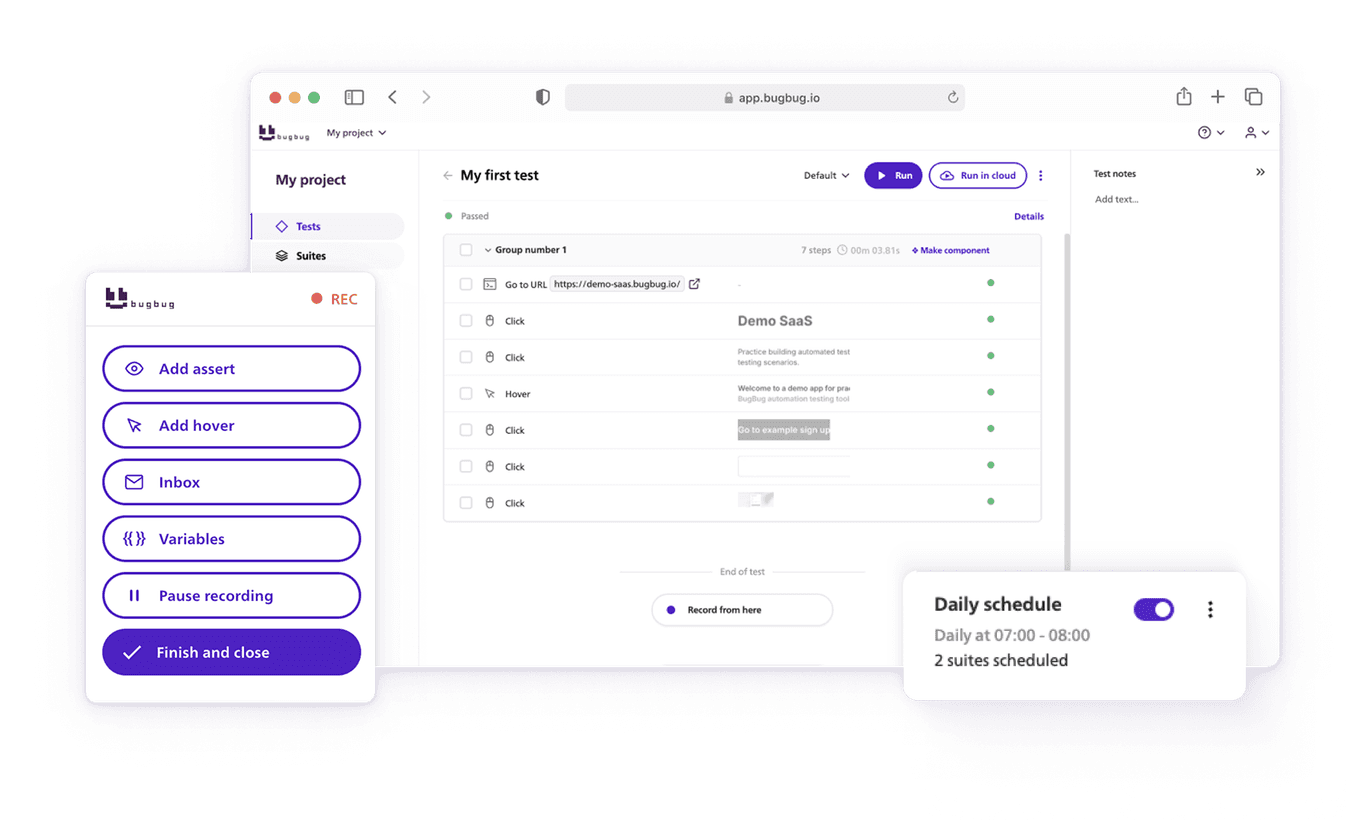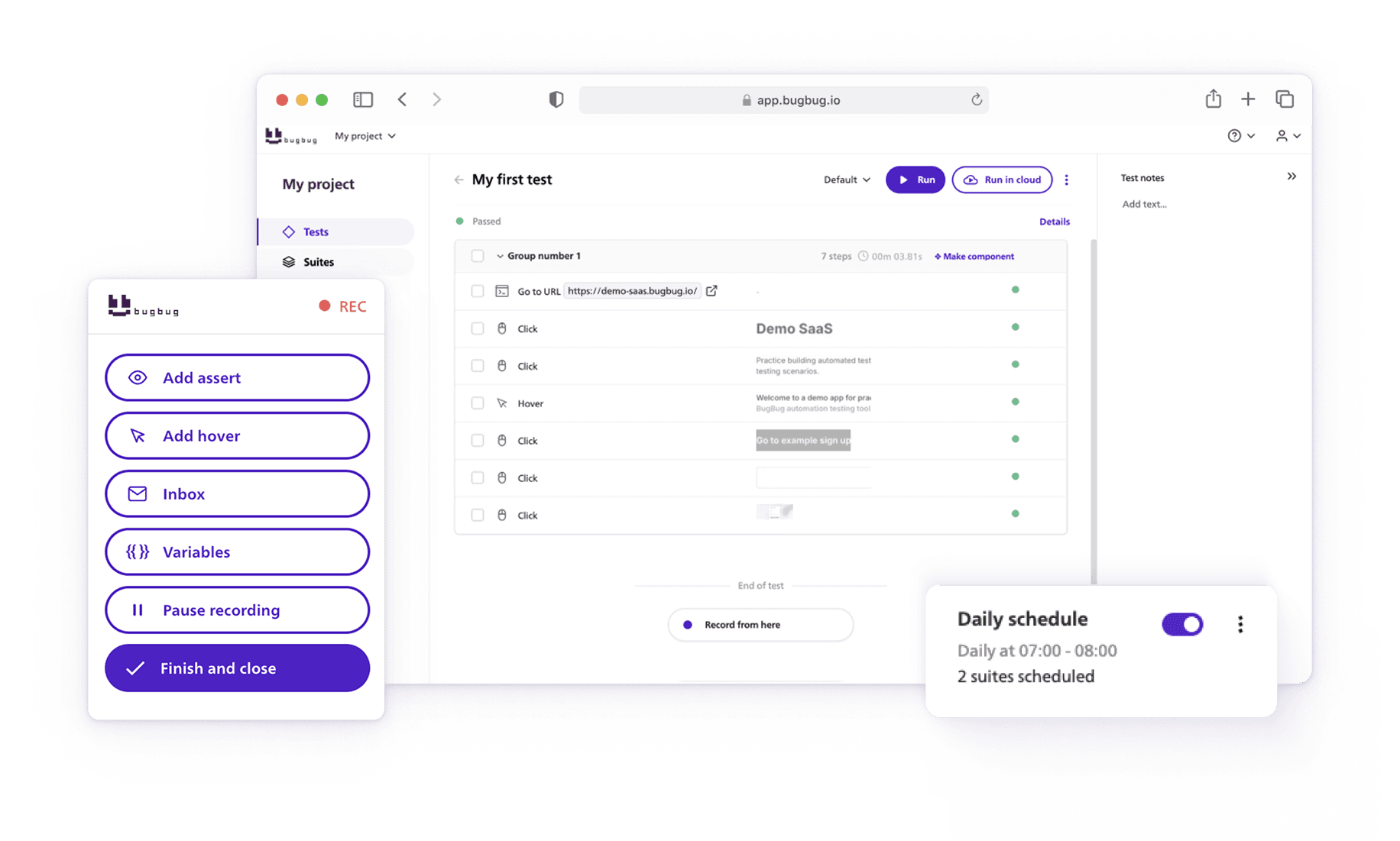- 🎯TL;DR: Feature Testing
- What is Feature Testing?
- Why is Feature Testing Important?
- How Does Feature Testing Fit Into the Development Process?
- How to Perform Feature Testing Effectively
- Feature Testing Methods
- Benefits of Feature Testing
- How is AI Used in Feature Testing?
- Feature Flags & A/B Testing
- How to Do Automated Feature Testing with BugBug?
- How is Feature Testing Different from Other Types of Testing?
- When Should You Stop Testing a Feature?
- Advantages of Feature Testing - Final Thoughts
Software development is all about building great features that users love. But how do we ensure that these features work as intended? That’s where feature testing comes in. In this guide, we’ll break down everything you need to know about feature testing in a way that’s easy to understand.
🎯TL;DR: Feature Testing
- Ensures High-Quality Features – Feature testing verifies that new or modified functionalities work as expected, preventing bugs and improving user experience before deployment.
- Reduces Costs & Risks – Detecting issues early in development minimizes expensive post-release fixes and ensures smooth software performance.
- Supports Agile & DevOps – Feature testing integrates seamlessly into iterative workflows, allowing rapid feedback, controlled rollouts, and quick adjustments.
- Uses Automation & AI – Tools like BugBug enable codeless automated testing, while AI enhances test coverage, speeds up execution, and improves accuracy.
- Validates Feature Rollout – Techniques like A/B testing and feature flags help optimize configurations, monitor user interactions, and ensure a successful release.
Check also:
👉Top 15 Codeless Automation Testing Tools for QA
👉Testing Tools for Web Application - The Ultimate Guide
👉Web Test Recorder - Which One Is The Best?
What is Feature Testing?
Feature testing is a type of software testing focused on checking whether individual features of an application function correctly. Whenever a new functionality is added or an existing one is modified, it needs to be tested to ensure it works as expected without introducing new issues. This process involves standard software testing practices, including functional testing, to verify the intended behavior of the feature.
The main goal of feature testing is simple: make sure the feature is bug-free and improves the user experience.
By using feature testing within the broader software development process, teams can validate that features perform as required before deployment. Testing allows developers to detect problems early, reducing costly fixes later in the software development life cycle. Effective feature testing also includes test scenarios that mimic real-world user interactions, ensuring smooth performance in different conditions. Additionally, field testing can be used to evaluate how the feature behaves in an actual operational environment. Identifying the best feature configurations through iterative testing helps optimize product quality and user satisfaction.
Why is Feature Testing Important?
Skipping feature testing can lead to unexpected bugs, broken functionalities, and a poor user experience. Here’s why feature testing is essential:
- Catches Bugs Early: Identifies problems before the feature reaches users.
- Ensures Consistency: Confirms that features function properly across different scenarios.
- Improves Product Quality: A well-tested feature contributes to a more stable and reliable application.
- Saves Time and Money: Fixing issues early is much cheaper than after deployment.
- Helps Meet Business Requirements: Ensures that new features align with business goals.
How Does Feature Testing Fit Into the Development Process?
Feature testing is a crucial step in the Software Development Lifecycle (SDLC). While it primarily happens during the testing phase, it influences multiple stages:
- Planning: Developers consider how new features will work.
- Development: Features are coded and prepared for testing.
- Testing: Feature testing takes place to verify functionality.
- Deployment & Maintenance: Features are monitored and refined based on real-world use.
In Agile and DevOps workflows, where updates happen frequently, feature testing plays a crucial role in catching issues early and ensuring smooth releases.
How to Perform Feature Testing Effectively
Feature testing is an integral part of the software development process. To implement feature testing effectively, developers should start testing the features early to ensure that they function correctly. Here’s a structured approach to performing feature testing:
- Define the Testing Objective: Understand the goal of the test and whether the feature meets business requirements.
- Create Comprehensive Test Scenarios: Identify multiple variations of a feature and consider A/B testing to validate if the feature will be good for deployment.
- Introduce Feature Tests: Run a feature test via feature flags (aka feature toggles) to enable the feature selectively for controlled user groups.
- Perform Feature Testing Before Release: Test the feature in staging environments to ensure quality and detect potential issues before production.
- Validate Feature Variable Values: Test different configurations associated with the feature to optimize performance.
- Incorporate Agile Testing Methods: Feature testing allows for iterative improvements and better integration with agile workflows.
- Run Feature Tests for Comprehensive Testing: Include functional testing, performance testing, and regression testing to ensure robustness.
- Monitor Feature Rollout: Use feature experimentation and A/B testing to compare different versions of the feature and determine which provides the best feature experience.
- Disable Your Feature if Necessary: If issues arise, use feature flags to turn off or modify the feature without redeploying the entire application.
- Test the Feature Again Post-Fixes: Validate that bugs have been resolved without introducing new problems.
Integrating feature tests into your feature delivery process ensures high-quality releases. By testing new features thoroughly, developers can refine their approach and conclude testing when the feature is ready for users. Implementing effective testing methods ensures that the new feature integrates seamlessly into the application while maintaining stability.
Feature Testing Methods
There are two primary ways to test features:
1. Manual Testing
- A human tester interacts with the software to verify the feature works as expected.
- Best for early development and exploratory testing.
2. Automated Testing
- Uses tools and scripts to run test cases automatically.
- Great for repetitive testing and large-scale applications.
Benefits of Feature Testing
Feature testing is more than just a checkbox in the development process. Here’s what you gain:
- Validates Feature Performance: Ensures it works as intended.
- Optimizes Configuration: Helps find the best settings for a feature.
- Prevents Deployment Issues: Reduces the risk of post-release problems.
- Improves User Experience: Leads to a smoother, more enjoyable product.
- Provides Valuable Insights: Helps understand user behavior.
How is AI Used in Feature Testing?
AI testing tools are often used in feature testing.
- Recognizing On-Screen Elements: AI can identify UI components just like a human.
- Interacting with Objects Smartly: AI-driven tools mimic real user interactions.
- Speeding Up Test Creation: AI can generate test scripts automatically.
Feature Flags & A/B Testing
- Feature Flags: Allow developers to enable/disable features without redeploying code.
- A/B Testing: Compares two versions of a feature to see which performs better.
- Feature Flag Testing: Ensures that feature toggles function correctly.
How to Do Automated Feature Testing with BugBug?

You can focus on specific app features (like a login module or search bar) to test them independently.
Steps:
-
Open bugbug.io and create a new test
-
Enter the URL where the feature exists
-
Click “Start recording”
-
Interact only with the feature — e.g., log in, use a filter, or submit a form
-
Use the test editor to validate that the feature worked as expected (e.g., “Welcome” message)
-
Click “Finish and close”
-
Run the test — this is your feature-specific test case
For those looking for a reliable, user-friendly, codeless solution, BugBug makes automated feature testing simple and efficient. With BugBug, you can run feature tests without writing code, ensuring new functionality is validated quickly and efficiently. The platform allows you to create test scenarios, automate repetitive tasks, and execute tests in Chrome.
Key Advantages:
👾 Cost-Effective Solution: BugBug is significantly more affordable than many other E2E test automation tools, making it an excellent choice for teams with budget constraints.
👾 User-Friendly Interface: The intuitive and simple UI ensures that even non-technical team members can create and manage tests efficiently.
👾 Codeless Test Automation: With BugBug’s no-code test creation, teams can easily automate their testing workflows without requiring programming skills.
Getting Started with BugBug
Starting feature testing with BugBug is quick and easy:
- Sign Up for a 14-Day Free Trial: Explore the full capabilities of BugBug without commitment.
- Use the Freemium Plan: Even after your trial, BugBug offers a feature-packed free plan for continued testing. Check out the full pricing.
- Create Your First Test: Set up codeless automated tests to validate your features effortlessly.
- Run Feature Tests in Chrome: Ensure compatibility and reliability across different environments.
- Integrate BugBug into Your CI/CD Pipeline: Automate feature testing to streamline your development workflow.
With BugBug, you can confidently test new features before release, optimize performance, and ensure your software maintains the highest quality standards.
How is Feature Testing Different from Other Types of Testing?
- Feature Testing vs. Regression Testing: Feature testing checks new/modified features, while regression testing ensures old features still work.
- Feature Testing vs. Unit Testing: Unit testing checks small code components in isolation, whereas feature testing verifies complete functionalities.
- Feature Testing vs. Feature-Based Testing: Feature-based testing organizes testing around features rather than the full application.
When Should You Stop Testing a Feature?
You can consider testing complete when:
- All Test Cases Are Executed: Positive, negative, and edge cases are covered.
- All Bugs Are Fixed & Re-Tested: Issues are resolved and verified.
- Feature Meets Acceptance Criteria: It functions as expected.
- Stakeholders Are Satisfied: Team members agree the quality is acceptable.
Advantages of Feature Testing - Final Thoughts
Feature testing plays a vital role in delivering high-quality software. By validating new features early, you can catch bugs, optimize performance, and improve user experience. Whether done manually or using automated tools, proper feature testing ensures that your software meets user expectations and business requirements.
Next time you roll out a new feature, ensure it’s tested properly—your users will thank you!
Happy (automated) testing!



